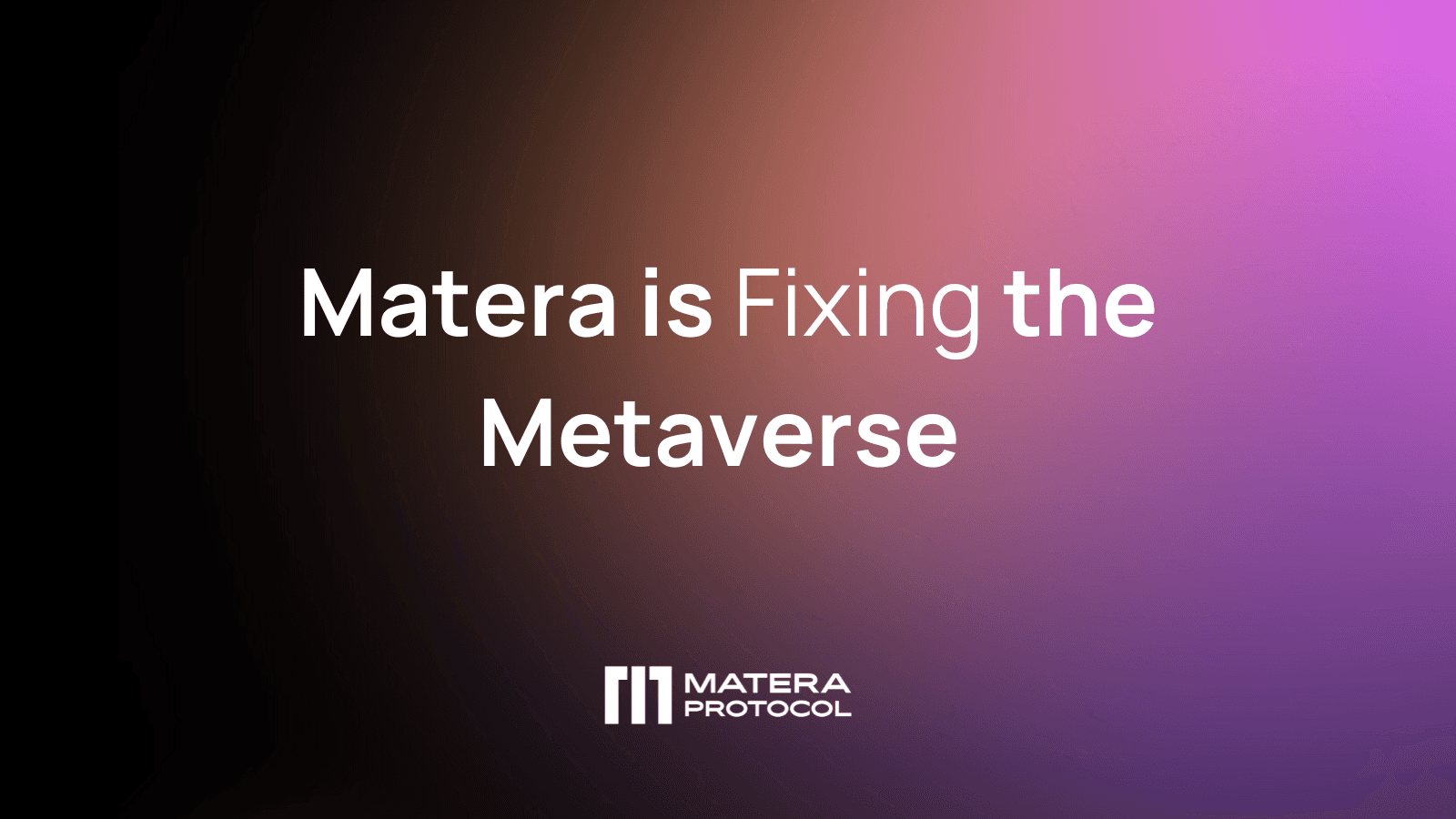Back to Blog
How Matera is Fixing the Metaverse’s Problem
Nov 17, 2023
Callum Moates

As the metaverse continues to grow and form larger audiences, it will completely change how we create, consume, and monetize online content. However, this space is starting to show roadblocks for creators looking to make a mark. Those that wish to develop 3D experiences and assets in the metaverse face multiple challenges; such as assigning intellectual property (IP) to digital assets with physical counterparts, protecting assets from copycats, or even monetization options, as it requires a lot of custom development, which most don't have the resources or skills for.
Matera is a protocol that aims to improve the metaverse, building a fairer 3D internet by solving difficulties with content quality and accessibility of content development. The protocol's different features, which includes an SDK, tokenization options, and a Layer 2 infrastructure, allow creators to build cutting-edge 3D experiences and bring them on-chain seamlessly so they can be verified, tokenized, monetized and keep their communities engaged.
The Problem
Having worked with over 200 clients, from Fortune 500 companies to top tier IP, governments, and web3 projects, to build their 3D experiences across various platforms, we noticed that creators building experiences in the metaverse face several challenges that include:
1. Measuring success in virtual worlds
Creators often face challenges in accurately measuring the success of their virtual worlds and assets, which can involve tracking user actions and understanding the performance of their experiences such as traffic, engagement, referrals, and transactions. Without these measurements, creators operate without valuable insights, and are unable to optimize and scale virtual activations and improve the experience for their users.
2. Protecting intellectual property (IP) rights in virtual environments
The incorporation of real-world IP into virtual worlds introduces legal complexities. Creators, including Fortune 500 companies and individuals, may struggle scaling this landscape surrounding virtual representations of physical assets, buildings, businesses, and branded characters. The lack of clarity on safeguarding these creations poses a big challenge. For instance, the luxury bag manufacturer Hermès filed a lawsuit against ‘MetaBirkin’ NFTs, which are digital replicas of the French luxury brand’s iconic handbag.
3. Ensuring user protection in the face of replication
The advancement of generative AI has made replicating virtual content, including complex structures, increasingly accessible. Creators are concerned about protecting users from unauthorized replicas and potential scams. Establishing ownership proof, just like verified accounts on social media platforms, is crucial to ensuring the communities' trust. For instance, a prominent virtual art gallery owner could be a victim of unauthorized replicas of its unique digital art pieces created through simple AI models, making it difficult for consumers to differentiate it from the original art. Examples like this raise concerns about protecting the authenticity and value of the original creations within the metaverse.
4. Designing a reward system for user engagement
In the metaverse, maintaining user engagement is vital for the success of virtual worlds. Creators seek effective ways to reward users for their engagement and specific actions within the content. Establishing reward systems incentivizes users to engage with these experiences, building loyalty among the fanbase and contributing to the overall success of the virtual world. An example we like to use is the fact that a creator can build a metaverse experience where players receive virtual rewards and unique in-game items based on their level of engagement. The more engagement, the higher value the reward.
5. Exploring innovative monetization models for the 3D internet
Creators continuously search for avenues to generate more revenue from their user base. Not just in web3, but in web2 as well. Traditional internet monetization models, such as advertising and subscriptions, may not fully capture the potential of the metaverse. Creators are eager to identify new monetization models native to virtual worlds that are tailored to the space and have the ability to unlock additional value beyond existing channels. Developing a way to let users buy, invest, and sell in the metaverse is a challenge most 3D internet builders need to overcome if the space is to develop and grow.

The Solution
Matera is an all-in-one toolkit for creators offering a solution to the challenges mentioned above, powered by blockchain technology and a Layer 2 infrastructure. Matera's ultimate goal is to become the backbone of the metaverse, which would benefit all digital stakeholders, including developers, creators, and consumers, by establishing a more level playing field. It will allow individuals to seamlessly integrate their 3D experiences onto the blockchain to benefit from verification, tokenization, and monetization of their assets.
Here are the main ways Matera aims to solve the metaverse’s challenges:
Verification of assets
Creators can protect their digital creations in the metaverse by using the verification feature offered by Matera. They can connect their 3D models of spaces and mint Asset NFTs (non-fungible tokens) to establish the authenticity of their creations. A group of trusted verifiers, incentivized by Matera, are responsible for verifying the authenticity of assets. Once the verification is completed successfully, a unique hash is recorded on-chain, representing the 3D asset and then a certificate of authenticity is sent to the creator's wallet and is publicly accessible. Verified assets also gain additional features, such as tracking by Matera Analytics for traffic, engagement, and revenue measurement.
Tokenization and monetization of assets
The Asset tokenization feature of Matera creates a new monetization and engagement model in the metaverse. Creators can tokenize a verified asset they created into 100,000 Asset Tokens. A dedicated asset treasury wallet is then created to store the Asset Tokens and future revenue generated by the asset. Creators are able to control the distribution of the Asset Tokens by using them as rewards for user engagement, selling tokens to investors to raise capital for further development, or trading their tokenized experience on NFT marketplaces like OpenSea. A major benefit for Asset Token holders is that they're entitled to rewards funded from the revenue generated by the asset, creating a direct connection between consumer engagement and creator benefits. For instance, a brand in the metaverse could launch a virtual hangout space where consumers can own a part of the experience through Token Assets, allowing for monetization of the experience while also allowing consumers to earn benefits and rewards as the experience gains traction.
Tracking analytics to determine performance and asset value
Creators no longer need to operate in the dark, unaware of their users' likes and dislikes or behavior within their digital experience. By understanding the performance of their 3D experiences, creators can gain more insight into the value of their 3D creation and build better experiences in the future. Matera offers analytics tracking for verified assets, providing traffic, engagement, and asset transaction data. This information is crucial to determining an asset’s ROI, ensuring better decision-making by the creator, and highlights monetization opportunities.
If an experience has better performing metrics, the Asset will generate more value. Asset data is publicly available and helps users and investors understand which assets to invest their money in. The value of these tradable tokens will rise with increased demand, raising the asset's value, too.
Overall, the Matera protocol is designed to create a positive feedback loop. Consumers engaging with 3D experiences receive Asset Tokens as rewards. Higher Asset performance based on factors like traffic, engagement, and monetization metrics, recorded through Matera’s analytics, means higher rewards and increases the attractiveness of Asset Tokens. Consumers can also become investors by purchasing additional Asset Tokens, contributing to increased demand and driving up the prices of the tokens. With an increased Asset value, creators have larger funds to build more content or drive up user rewards. This positive feedback loop will benefit both creators and users.

Conclusion
Matera aims to be the fairness layer, ensuring the equitable distribution of wealth in the metaverse, in contrast to the dominance of a few large companies in web2 currently. We aim to create an ownership economy where consumers become stakeholders in the 3D internet by owning and trading experiences in the metaverse as Asset Tokens.
Matera Protocol arrives as a robust solution for creators, developers, and users by democratizing content production, and creating authenticity by verification, and creating a positive feedback loop with its unique tokenization and monetization features.
Are you a developer, creator, or brand looking to build 3D virtual experiences and assets for your community? With the Matera Protocol, we can help you verify, tokenize, monetize, and track your digital content in the metaverse. Learn more about Matera here.
Nov 17, 2023
Callum Moates
Subscribe to our monthly newsletter
About Landvault
Landvault is building infrastructure to accelerate the metaverse economy, by building tools to create, deploy and monetize content. The company has helped over 200 clients enter the metaverse, including both Fortune 500 companies and government organizations like the Abu Dhabi government, Mastercard, L’Oreal, Red Bull, and Heineken. The company has raised a total of $40m over the past three years and continues to pioneer technological advancements.
